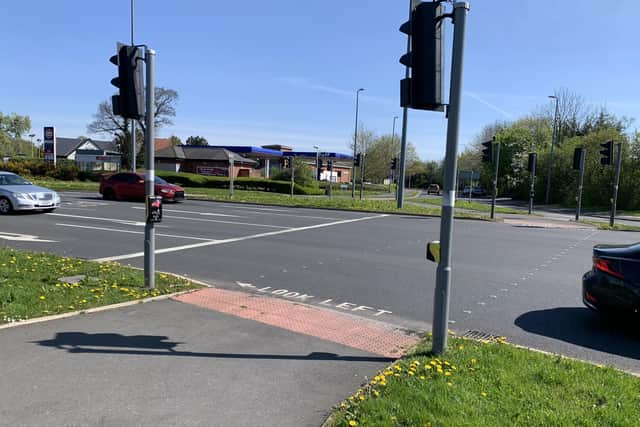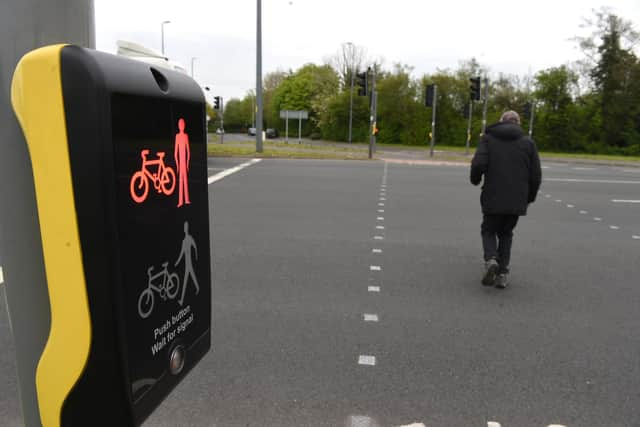Panic at Penwortham's puffin crossing - why people think they only have 8 seconds to cross 4 lanes of traffic and why it's not the case
and live on Freeview channel 276
People have reported feeling "panicked" and "daunted" at the prospect of navigating four lanes of the 50mph A582 Golden Way in Penwortham.
Lancashire County Council (LCC) say sensors on the puffin crossing towards Millbrook Way allow up to 24 seconds to cross, but most people spoken to by the Post are under the impression they only have eight seconds – and one man has even reported being stranded in the middle of moving traffic when the sensor didn't spot him.
Factors


Advertisement
Hide AdAdvertisement
Hide AdA 'green man' only displays at this site for eights seconds - something people say they are focusing on and expect traffic lights to turn green as soon as the red man appears.
But LCC say this is not the case - that the green man is only an 'invitation to cross' and the red traffic lights are held much longer.
The issue is aggravated by a lack of a central refuge island and there is also no 'bleep' on the crossing for deaf or deaf-blind pedestrians, though LCC say this is because of the proximity to other crossings in the area and the potential for confusion.
Read what LCC have to say in full at the bottom of the story


The father of a disabled child who has used the crossing, but asked not to be named, said: "As a pedestrian you have no way of knowing the new way of how it works.
Advertisement
Hide AdAdvertisement
Hide Ad"You look for the green man changing to red, and when it does and you're not across the road, the panic factor sets in.
"This is four lanes of fast-moving traffic, and it's daunting."
One 64-year-old man on his way home to Whitestake from Booths supermarket in Millbrook Way said the green man had automatically come on as he approached the crossing, and as he walked over, the traffic lights changed.


He said: "Because I didn't press the button and set off across when the green man had already been on for a couple of seconds, the sensor must not have picked me up.
Advertisement
Hide AdAdvertisement
Hide Ad"I was literally stuck in the middle of the road and cars stopped to let me cross. It was terrifying. It knocks your confidence.
"You never know if it's going to happen again, so now I'm very wary and I don't hang around - I get across it as quickly as possible."
Lancashire County Council has not responded to these claims or questions about the reliability of the sensors.
Walking speed
The designed walking speed for pedestrian's crossings in the UK is 1.2m per second, meaning an average able-bodied person should be able to cross the 16m distance in 13.3 seconds.
Advertisement
Hide AdAdvertisement
Hide AdWhen the Post visited, an able-bodied 36-year-old crossed the 16m stretch in 12 seconds.
But research by University College London shows that most people over the age of 65 would need in the region of 20 seconds to cross the road.
LCC say that if the walking speed was lower, the sensor would recognise this, and allow up to 24 seconds for the crossing.
>>>Here are some of the other new crossings in Preston
Advertisement
Hide AdAdvertisement
Hide Ad"LCC always sticks to the guidance", said Mel Close, chief executive of Disability Equality North West.
"But organisations like ours would point out that it is only guidance, and that it accounts only for an average person on an average day, in average conditions. It doesn't mean you can't go above and beyond."
Research from University College London shows that most older adults cannot walk fast enough to use a pedestrian crossing in the UK.
The study showed the normal walking speed was below 1.2m per second for 76 per cent of men and 85 per cent of women aged 65 and over.
Advertisement
Hide AdAdvertisement
Hide AdThe average walking speed was 0.9 metres per second in men and 0.8 metres per second in women. Based on those calculations, it would take a female pensioner 20 seconds to cross the 16 stretch.
Mel added: "Twenty per cent of our population is disabled, then you have older people as well.
"This is quite a wide road - not quite wide enough to need a refuge point in the middle - and there is a panic for some people in that.
"If you're blind or deaf-blind, then you'll need to feel for the turning knob, and so you're losing a second or two before setting off, doing that. It takes time to feel for it and then to act on that information."
Advertisement
Hide AdAdvertisement
Hide AdShe added: "So yes, the guidance might be being followed, but is it fit for purpose?
"We acknowledge the needs of the drivers, but I'm sure most people wouldn't mind waiting a couple of extra seconds.
"We would call on LCC to look at these timings across the county. If they are committed to promoting independence and wanting people to go to places like the supermarket themselves, then this needs to be considered for people with mobility issues."
On the issue of sensors, Mel added: "If the sensor picks you up, and it works, then great, more time is something we'd welcome. But we have to make sure that the sensor is picking people up.
Advertisement
Hide AdAdvertisement
Hide Ad"And I think educating the public is a big thing here. LCC need to be explaining how these crossings work on their social media and websites."
What Lancashire County Council says:
A spokesman for Lancashire County Council said: "The modern type of pedestrian crossing is known as a puffin crossing, and works in quite a different way to the old style of crossing known as a pelican crossing, which is gradually being phased out.
"The biggest difference is that, whereas the old-style pelican crossings allow a fixed amount of time to cross, puffin crossings have a sensor which can see you waiting to cross, as well as whilst on the crossing and, if necessary, extend the red light for traffic to allow you to safely reach the other side.
"Another key difference is that while the old pelican crossings display a red/green man on the opposite side to let you know when the lights are changing as you cross, pelican crossings display the red/green man on a box on your side of the road, which helps people watch the traffic and signals at the same time before they cross, and makes the crossing easier to use for people with visual impairments.
Advertisement
Hide AdAdvertisement
Hide Ad"The pedestrian crossing on the A582 at Millbrook Way allows a maximum time to cross of 24 seconds from when the green man comes on, and a minimum time of 16 seconds if people set out just before the green man changes to red.
"This is within Department for Transport guidelines and balanced towards the needs of pedestrians, including those who may take longer to cross, as this is a busy road with a 50mph speed limit.
"We will always consider adjusting the timings of pedestrian crossings when people approach us with issues, and we would ask anyone who experiences problems using a crossing in their area to get in touch.
"Information is available online about how puffin crossings work, however we are also looking to improve our own website, and carry out some promotion to improve people's understanding."